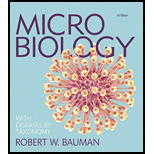
Concept explainers
To determine:
How a proper application of Koch’s postulates would have prevented the misnaming of Haemophilus influenzae, which was named so because researchers isolated the organism from flu patients.
Introduction:
Haemophilus influenzae is an extremely small Gram negative
Want to see the full answer?
Check out a sample textbook solution
Chapter 20 Solutions
Microbiology With Diseases.. -Masteringmic.
- Which of these statements about Streptococcus pyogenes is false?a) It is a Gram-positive coccus occurring in chains.b) Some strains that infect wounds can cause toxic shock.c) Some strains that infect wounds can cause necrotizing fasciitis.d) It can cause puerperal fever.e) A vaccine is available for preventing S. pyogenes infections.arrow_forward1) How does cholera kill people? 2) What was Dr. Snow's initial hypothesis on the cause of cholera? 3) What methods did Dr. Snow use to test his hypothesis? 4) What was "The Report That Changed The World" ? 5) What is a voronoi diagram? 6) What is the definition of an "A B Test" ? 7) Name a place where cholera is still a problem today. 8)What public health policies would you apply to help that place?arrow_forwardThree to five days after eating Thanksgiving dinner at a restaurant, 112 people developed fever and gastroenteritis. The dinner consisted of Roast Turkey, turkey giblet soup, mashed potatoes and crushed giblet gravy. The gravy was not refrigerated and was served the entire Thanksgiving day. The analysis of leftover food showed the same bacteria as was isolated from patients. a) What was the source of illness? b) What was the most likely microbe causing this illness? c) Was this an infection or an intoxication?arrow_forward
- This bacterium is a Gram-negative diplococci that possesses a capsule; finding these cells in cerebrospinal fluid (CSF) is a preliminary diagnosis for the deadly disease it causes. What is bacterium? A) O Streptococcus pneumoniae B) O Neisseria meningitidis C) O Cryptosporidium parvum D) O Clostridium tetani E) O Staphylococcus aureusarrow_forwardStaphylococcus aureus can be responsible for all of the following conditions excepta) impetigo. b) food poisoning.c) toxic shock syndrome. d) scalded skin syndrome.e) athlete’s foot.arrow_forwardWhich of the following is true regarding pathogenic strains of Staphylococcus and Streptococcus, respectively? A) O Staphylococcus aureus is a common cause of sore throats. B) O Alpha-hemolytic Streptococci turn blood agar green and include members that cause pneumonia and tooth decay, C) Gamma-hemolytic Streptococci completely lyse red blood cells on blood agar. D) O The beta-hemolytic group of Streptococci does not contain any pathogenic types.arrow_forward
- Which of the following about Staphylococcus aureus is false?a) It is generally coagulase-positive.b) Its infectious dose is increased in the presence of foreign material.c) Some strains infecting wounds can cause toxic shock.d) Nasal carriers have an increased the risk of surgical wound infection.e) It is pyogenic.arrow_forwardThe following are the limitations of Koch's postulates EXCEPT: A. some pathogens cannot grow on artificial media and therefore cannot be identified as the causative agent of the disease B. some diseases involve multiple pathogens which produce similar symptoms making it difficult to pinpoint the causative agent C. some diseases are host-specific and re-inoculation may pose ethical concerns D. some microorganisms are present in the body fluids of the infected animal which make them difficult to be culturedarrow_forwardTwo microbiologists are writing a textbook, but they cannot agree where to place the discussion of botulism. One favored the chapter on nervous system infections, whereas the other insisted on the chapter covering digestive system infections. Where do you think the discussion should be placed, and why?arrow_forward
- What is the most common type of nosocomial infection?a) Bloodstream infection b) Gastrointestinal infectionc) Pneumonia d) Surgical wound infectione) Urinary tract infectionarrow_forwardWhat were Koch’s postulates?arrow_forwardThe following phenotypic change of a bacterium is possible by transfer of DNA by"'conjugation".A) ability to produce toxin.B) Develop antibiotic resistance.C) Production of virulence factorD) All of the above statements are true.arrow_forward
